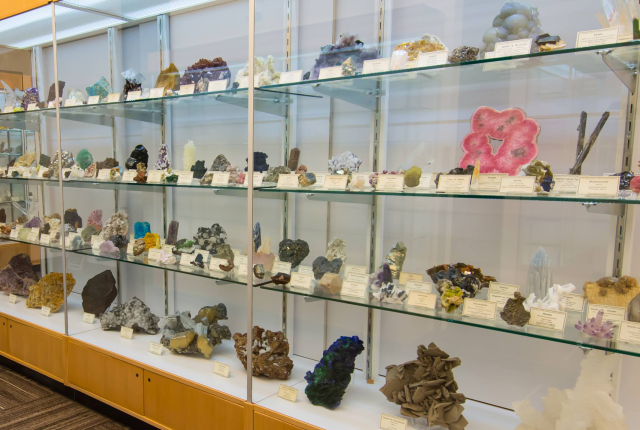THE GEODES AND TURQUOISE draw most visitors, Kelsey McNamara tells me. The curator of the Mineral Museum on the New Mexico Tech University campus, in Socorro, interrupts my reverie at a vitrine outlining what kind of turquoise comes from each of the mines in New Mexico.
I give up trying to memorize which one has the sky-blue color versus the jade-like green and invite her to walk me through the rows of tall cases holding everything from a spiky white sample of scolecite from India to a piece of uranium mined in New Mexico for nuclear weapons and research. “It’s not super radioactive,” McNamara assures me.
Nestled into the Headen Center, the museum shows rotating exhibits of approximately 15,000 specimens. These include small-to-forearm-size blobs of bluish smithsonite from the former Kelly Mine, in Magdalena, deep-blue halite from Eddy County’s Carlsbad Potash District, azurite from Lordsburg’s Atwood Mine, and an amethyst found in Grant County. International varieties fill other shelves with an array of colors, fantastical shapes, and varying degrees of translucency.
Read more: Near Las Cruces, a hike to ancient petroglyphs brings whispers of the past.
“It’s written into state law that we maintain a collection,” McNamara says. “Our main focus is to have the best pieces from New Mexico.”
The museum also has displays of mining equipment, gems worked by lapidarists, and a case titled “Meteorites and Meteor-wrongs” that opened my eyes to how hematite and mining slag can mimic cosmic debris. One set of cases features the microcollections from key supporters, who help raise money for new purchases.
“We have a wish list,” McNamara says. “I’d love to have some Sweet Home rhodochrosite, but it’s just too much money. Maybe some cubanite from Quebec?”
As director of the New Mexico Bureau of Geology and Mineral Resources at the college, Nelia Dunbar serves as state geologist. She encourages museum visitors to wander the building to see all the rock-related art on the walls.
“You should also take a walk around the campus,” she says, citing the petrified-wood fountain in front of the Headen Center, the path around the golf course, and a rattlesnake sculpture up the hill from it. But mostly, she says, “I would focus on having enough time to look at the entire museum.”
Read more: Afton Love explores grand questions by detailing the tiniest of changes.
Mineral Museum
Headen Center at New Mexico Tech University
Bullock Boulevard and Leroy Place, Socorro; 575-835-5490
ROCK ’N’ ROLL
Indulge your inner rockhound with these tips.
STATE GEOLOGIST NELIA DUNBAR recommends that you follow a visit to the Mineral Museum by hitting the road—the Quebradas Backcountry Byway, to be specific. The 24-mile unpaved county road snakes northward just east of Socorro before curving back. It traverses rolling bench lands and eroded waterways that reveal a wealth of geologic material. “You’ll see some great geology,” Dunbar says. “Where there’s great geology, there’s great minerals.”
Stock up on geology guides at the Mineral Museum’s gift shop and download a PDF with info on rock clubs, rules for collecting, and a description of the geology you’ll see on a drive from the Albuquerque Sunport to Socorro at nmmag.us/rockhoundguide.


